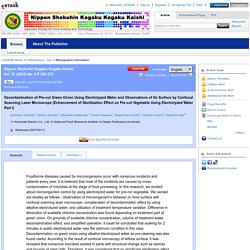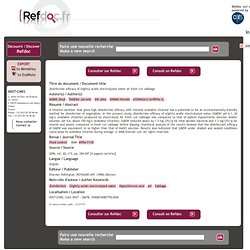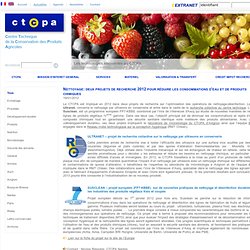

JOURNAL OF FOOD SCIENCE—Volume 64, No. 2, 1999 Electrolyzed Water as a Disinfectant for Fresh-cut Vegetables. Journal of the Japanese Society for Food Science and Technology - 2005 - Decontamination of Pre-cut Green Onion Using Electrolyzed Water and Observations of Its Surface by Confocal Scanning Laser Microscope (Enhancement of Sterilization Effect on Pre-cut. Foodborne diseases caused by microorganisms occur with numerous incidents and patients every year.

It is believed that most of the incidents are caused by cross-contamination of microbes at the stage of food processing. In this research, we studied about microorganism control by using electrolyzed water for pre-cut vegetable. We carried out studies as follows ; observation of microorganism's behavior on food surface with confocal scanning laser microscope, consideration of decontamination effect by using alkaline electrolyzed water, and utilization of treatment temperature variation. Difference in diminution of available chlorine concentration was found depending on treatment part of green onion. On grounds of available chlorine concentration, volume of treatment water, decontamination effect, and simplified operation, it could be concluded that soaking for 2 minutes in acidic electrolyzed water was the optimum condition in this case. IWATE UNIVERSITY (Japon) - Faculty of Agriculture - Effects of mildly heated, slightly acidic electrolyzed water on the disinfection and physicochemical properties of sliced carrot.
FOOD PRESERVATION SCIENCE - 2003 - Spray application of electrolyzed water on leaf surfaces for growth promotion and quality improvement of Mitsuba (japanese honewort, Cryptotaenia japonica Hassk) in solution culture. Rev. Iber. Tecnología Postcosecha Vol. 11(2):204-213 2011 LA DESINFECCIÓN CON AGUA ELECTROLIZADA PRESERVA LA CALIDAD MICROBIOLÓGICA, NUTRITIVA Y SENSORIAL DE BROTES DE MIZUNA MÍNIMAMENTE PROCESADOS EN FRESCO. EFFICACY OF NEUTRAL AND ACIDIC ELECTROLYZED WATER FOR REDUCING MICROBIAL CONTAMINATION ON FRESH-CUT FRUITS. Food Control March 2009, vol. 20, no3, pp. 294-297 Disinfection efficacy of slightly acidic electrolyzed water on fresh cut cabb.
Titre du document / Document title Auteur(s) / Author(s) Résumé / Abstract A chlorine sanitizer that gives high disinfection efficacy with minimal available chlorine has a potential to be an environmentally-friendly method for disinfection of vegetables.

In the present study, disinfection efficacy of slightly acidic electrolyzed water (SIAEW: pH 6.1, 20 mg/L available chlorine) produced by electrolysis for fresh cut cabbage was compared to that of sodium hypochlorite solution (NaOCI solution: pH 9.6, about 150 mg/L available chlorine). SIAEW reduced about by 1.5 log CFU/g for total aerobic bacteria and 1.3 log CFU/g for moulds and yeasts, compared to fresh cut cabbage before dipping. Revue / Journal Title Source / Source 2009, vol. 20, no3, pp. 294-297 [4 page(s) (article)] Langue / Language Anglais Editeur / Publisher Elsevier, Kidlington, ROYAUME-UNI (1990) (Revue) K STATE UNIVERSITY - 2005 - Thèse en ligne : A REVIEW OF CHEMICAL DISINFECTION METHODS FOR MINIMALLY PROCESSED LEAFY VEGETABLES. ECOLE CATHOLIQUE DE LIMBOURG (Belgique) - 2009 - Thèse en ligne : ELECTROLYZED WATER AS A NOVEL DISINFECTANT TECHNIQUE ON MINIMA. Abstract :In order to guarantee the safety to consumers and to prolong the shelf life of minimally fresh processed (or fresh-cut) fruit and vegetables the industry needs to have efficient disinfectant procedures.
In general, the minimal fresh processing industry uses sodium hypochlorite (NaClO) because it is cheap, easily available and has a good disinfectant effect. However, this product has several disadvantages. In fact, it is potentially harmful for humans and the environment being currently forbidden in some European countries. Therefore, it is needed to search for a sustainable alternative for the industrial use of NaClO. The aim of this study was to investigate if electrolyzed oxidizing water (EOW), an emerging disinfectant, can effectively replace NaClO. Microbial analyses showed that NEW and AEW had similar effects on minimally fresh processed mizuna, modified atmosphere packed and stored up to 11 days at 5°C, compared to 100 ppm NaClO. Nettoyage : deux projets de recherche 2012 pour réduire les consommations d'eau et de produits chimiques. Le CTCPA est impliqué en 2012 dans deux projets de recherche sur l’optimisation des opérations de nettoyage-désinfection.

Le premier, Ultranet, concerne le nettoyage par ultrasons en conserverie et entre dans le cadre de la recherche collective du centre technique. Le second, Susclean, est un programme européen FP7-KBBE coordonné par l’Inra de Villeneuve d'Ascq qui étudie de nouvelles manières de nettoyer les lignes de produits végétaux IVème gamme. Dans ces deux cas, l’objectif principal est de diminuer les consommations et rejets d’eau et de composés chimiques tout en garantissant une sécurité sanitaire identique voire meilleure des produits alimentaires. Avec une visée «développement durable», ces deux projets impliquent le laboratoire de microbiologie du CTCPA d’Avignon ainsi que l’équipe de Nantes engagée dans le Réseau mixte technologique sur la conception hygiénique (RMT Chlean). ULTRANET – projet de recherche collective sur le nettoyage par ultrasons en conserverie.